North Carolina congressional maps may allow for as much as a 10-4 Republican majority in the U.S. House of Representatives as opposed to the current 7-7 split, according to Dillan Bono-Lunn, professor of political science and public policy and faculty fellow for Civic Engagement.
Bono-Lunn said gerrymandering, which is a term that describes how voting districts are drawn, has been done for years by both Republicans and Democrats.
“The connotation is that the districts are being drawn in a way to preference one party over another,” Bono-Lunn said. “There are more and less acceptable forms of gerrymandering.There's sort of an understanding that whichever party is in control, will likely draw the districts in a way that's going to preference them.”
As of Oct. 5, there were 2,418,633 registered Democrat voters, 2,298,019 registered Republicans and 2,912,447 unaffiliated voters, according to the NCSBE.
However, Bono-Lunn said because of the Voting Rights Act of 1965, there are strict rules against drawing district lines around race and ethnicity.
She said because of the Supreme Court Case Shelby County v. Harper, which was decided in 2013, North Carolina and other southern states no longer have to get their voting maps approved by the courts.
“Since then, there's been this, this back and forth of boundaries have been drawn, and they've been then challenged in the courts, including in the Supreme Court,” Bono-Lunn said.
The current North Carolina congressional maps, which were approved by the North Carolina General Assembly on Oct. 25, 2023, were challenged in the courts on grounds of racial gerrymandering, which is illegal because of the 1993 SCOTUS case Shaw v. Reno and the Fourteenth Amendment. In March, the Fourth Circuit Court of Appeals rejected an emergency challenge to the legislative maps. In June, three North Carolina Superior Court judges granted defendants’ motion to dismiss the case since it was partisan, and thus “non-justiciable.”
The newly drawn map redistributes North Carolina’s 14 congressional districts, favoring Republicans in 10, Democrats in three and designating one as a competitive district based on past election results. Presently, North Carolina’s congressional delegation is evenly split with seven Democrats and seven Republicans, as a court-ordered map was employed in the 2022 elections. Interactive graphic by Erin Martin.
Normally, redistricting happens every ten years, after the U.S. decennial census. These versions of the maps were the third drawn in three years.
While Gov. Roy Cooper is a Democrat, Republicans have a supermajority in the North Carolina General Assembly — which Bono-Lunn said means they can override a gubernatorial veto.
She said this breakdown is unlikely to change in this election, where she predicts Democratic candidate Josh Stein will win the governor’s seat and Republicans will keep the North Carolina House and Senate.
However, as three maps were redrawn — the North Carolina House and Senate maps and congressional map, which determines the U.S. House of Representatives and the Senate — they could have both local and national effects.
“With the new maps, it's almost certain that we're going to continue to have a Republican-controlled General Assembly, but the supermajority may or may not be there,” Bono-Lunn said. “That's where it could end up being very consequential, depending on which issues the General Assembly chooses to hear in the next session. Where the new maps might play in as well is at the federal level.”
Bono-Lunn said though gerrymandering prioritizes one party over another, redistricting can be important because it allows for minority candidates to get elected.
“It's quite interesting, actually, because there is some degree where that is desirable, because it increases the likelihood that you have candidates of color who get elected,” Bono-Lunn said. “It's always had this interesting tension.”
Alamance County is divided into two districts — the town of Elon and Elon University are represented by North Carolina House District 63, while southern Alamance County is located in District 64. Bono-Lunn said university students voting here could have an effect on the outcome of local elections.
“That still remains to be seen,” Bono-Lunn said. “How many students from Elon are voting locally, as opposed to in their home state or their home district But it could influence things.”
Bono-Lunn said redistricting happens all over the U.S., but North Carolina is unique in its history of disenfranchising Black voters, like many other southern states historically.
“We have another dynamic, because we are a southern state that has this history with the Voting Rights Act and federal involvement in how we draw our districts,” Bono-Lunn said. “But gerrymandering happens elsewhere in the United States and is not unique to the Republican Party. Democrats will engage in gerrymandering, too.”
She said though the maps may have an effect, voter turnout will decide the election.
“The maps aren't everything,” Bono-Lunn said. “It really depends on how many folks turn out to vote. That will ultimately determine which candidates win office, and that's how we normally think about how consequential these voting maps are, is how it affects who's representing us at the state or the federal level.”


